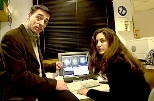CAMBRIDGE, Mass.--Looking at how the human brain builds memories of what a person has encountered and where that information came from, MIT researchers will report in the Feb. 18 Proceedings of the National Academy of Sciences that distinct parts of the brain build memories for two separate but related aspects of everyday experiences.
The two forms of memory were illustrated in the 2001 film "Memento," in which the amnesiac main character writes information down in an effort to remember it, but neglects to record the source of the information and is thus susceptible to manipulation. A more common experience is knowing you've met someone before but not remembering the person's name or any other details about the prior encounter.
Understanding how the healthy brain records and recalls memories for everyday experiences could assist in the development of early predictive tests for Alzheimer's disease, even for individuals with no obvious symptoms. Because Alzheimer's treatments primarily concentrate on slowing the progression of the disorder, earlier diagnosis could mean a better prognosis.
The researchers--Anthony Wagner, the Paul E. Newton Career Development Assistant Professor in Cognitive Neuroscience; Lila Davachi, a postdoctoral fellow in brain and cognitive sciences at MIT; and Jason P. Mitchell of Harvard--used the latest brain-imaging techniques to measure the activity in people's brains as they formed memories. These recordings allowed them to test whether activity in different regions of the brain were associated with different forms of learning and remembering.
Wagner and Davachi show for the first time that activity in the human hippocampus, a seahorse-shaped area in the medial temporal part of the brain, plays a particular role in building memory for the context of where and how we learned something, but does not play a role in remembering the thing itself.
Instead, building a memory for the item itself, devoid of source or context, seems to rely on learning mechanisms in the perirhinal cortex, a small strip of cortex underneath the hippocampus in the temporal lobe.
FORMING A MEMORY PICTURE
The hippocampus has long been known to play a role in long-term memory formation. Because it receives information from much of the surrounding cortex, the hippocampus is well-situated to combine separate features of an experience--such as what we encounter and the source or context surrounding the encounter--into an integrated memory in the brain, Wagner said.
However, data gleaned from studying brain-damaged patients has been sparse because there are few patients with brain damage restricted to the hippocampus or the perirhinal cortex. The MIT researchers used fMRI (functional magnetic resonance imaging) at the Martinos Center for Biomedical Imaging in Charlestown to better understand how the brain learns.
While in the fMRI scanner, people were asked to look at 400 adjectives and either read the words backward to themselves or generate mental images of spatial scenes related to the adjectives. For instance, subjects might imagine a garbage dump or messy room when prompted with the word "dirty." The researchers recorded the brain activity during the presentation of each word.
The next day, the subjects were asked to look at words again--some they had seen the day before and some they had not--and indicate whether they had been shown the word before.
When participants recalled seeing the word, they were asked whether they recalled visualizing a scene or reading the word backward. "In this manner, the memory test was used to index when the subjects had formed item memories either with or without source memories," Davachi said. Using this approach, the "brain data collected with fMRI the day before were used to see whether activation of the same or different brain regions correlated with learning item information or source information."
"Activity in the hippocampus didn't predict whether the participant would recognize or forget the word, but for those items that were recognized, hippocampal learning activation predicted whether the person would be able to remember the source," Wagner said. This pattern suggests that the hippocampus is central to our ability to remember the details surrounding an encounter with a person, place or object.
The other brain area, the perirhinal cortex, showed the opposite pattern. "This region built memories for the words, but did not predict whether the person would remember the source," Wagner said. This suggests that this region supports our ability to recognize people, places or things as familiar even if we can't remember any of the details. "The hippocampus and perirhinal cortex appear to use different yet complementary learning mechanisms to store different aspects of our everyday experiences in memory.
"Our ability to form memories changes as we age, and older adults typically have more extensive problems with source memory compared with item memory," Wagner said. "My lab tries to understand the neurobiological changes that take place during aging and how they translate into cognitive changes."
This work is supported by the National Science Foundation, the National Institute of Mental Health and the McKnight Endowment Fund for Neuroscience.






